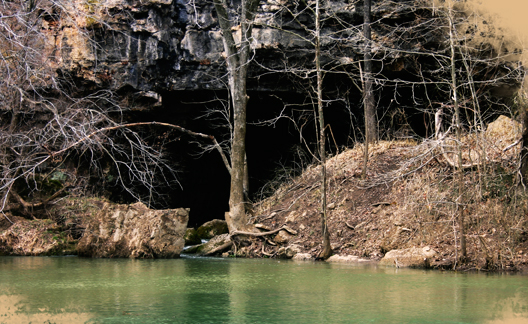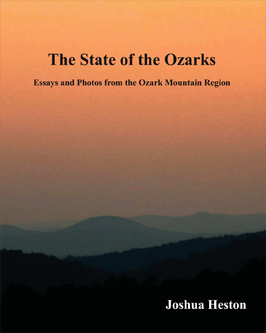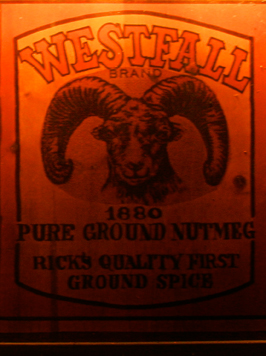Ozark Writers
by Joshua heston
Words have long been my friends. Perhaps it was my mom reading everything from Louis L’Amour to Rudyard Kipling to me when I was a very small child.
“I got tired of reading kids’ books,” she told me later. “So I figured I might as well read what I liked.”
Perhaps it was an early love of poetry by the likes of Sara Teasdale, Vachel Lindsay and Henry Wadworth Longfellow.
Maybe it was my latent Welsh heritage. Wales is a land where bards, storytellers, poets and writers have been celebrated from time immemorial.
But I cannot say for certain.
What I do know is, for as long as I can remember, words were magic. Color, texture, light, and weight, all contained by a few simple marks.
That’s real enchantment.
December 7, 2015
About the page...
The Ozarks have long inspired writers. From Henry Rowe Schoolcraft to Vance Randolph, history is populated by Ozark descriptions, aphorisms, histories and more... if you know where to look.
State of the Ozarks’ recent writing contest brought another reality to light:
There are more talented — but often unheard of — writers than we could have imagined. The Ozark Writers Section (of which this page is the first) is dedicated to those writers, past and present, who inspire, delight and challenge.
And what better way to initiate the new section than with a varied selection of some of my favorite works and quotes?
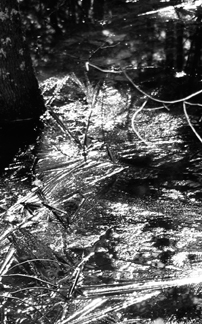
plate A. Ozark Trail near Klepzig Mill, February 20, 2009.
Fern Nance Shumate
I was, in my mind, transformed from a stocky farm girl into a fairy princess gliding through a winter wonderland with a fairy prince. The cold seemed to add to the eerie beauty....
We also swirled through ice-sheathed stark black silhouettes of trees with no trunks.... We had left the others far behind and were gliding all alone which added to the unreality of the night. As the moon rose we seemed to be racing with it, now the ice sparkled, now it seemed like tarnished silver as wisps of clouds scudded over the moon.
— Fern Nance Shumate, The Ozarks Mountaineer, February 1984
Clay Anderson
More and more frequently we are embarrassed by our fellow journalists. Local newspapers depend more and more on hand-outs and press releases for their editorial coverage. That is at least understandable to a degree because they don’t have the personnel and resources for the increasingly costly job of developing news stories.
But what appalls us most is the electronic media who have the resources and man power, and then dash around missing the real stories completely or else condensing them into unintelligible or misleading blurbs.
Consider a Springfield television station flying a crew all the way to War Eagle, Ark., by helicopter to report there was a traffic jam at the annual Ozarks Arts and Crafts Fair...and that rain makes mud.
For each of the 15 years we’ve been going to War Eagle there have been traffic jams...and we won’t go into how long we’ve known that rain falling on dirt turns it into mud.
— Clay Anderson, The Ozarks Mountaineer, December 1981
“This above all: to thine own self be true, And it must follow, as the night the day, Thou canst not then be false to any man.”
― Hamlet Act 1, scene 3
James Leon Combs
Though my dad let the fire in the old wood stove burn down, it still threw out plenty of heat. Radiant warmth from the burning wood felt good on my back that cold Friday November evening. Darkness signaled closing time, and the two of us were alone in the small general store that was our family business. Dad sat behind me on the other side of the stove, on the loafer’s bench. He had turned out the lights so as not to encourage some late arriving customer. Twilight darkness was broken only by the glare of the fire.
Dad had always been more like a best friend than a father.
— James Leon Combs, Bradleyville: My Hometown, 2003
James C. Hefley
Hog killin’ time came after the first frost. Neighbors and relatives helped one another on Saturdays. By sunup they had a fire blazing under a big black kettle filled with cold spring water.
When the water was boiling, Daddy pulled the hog from its pen, shoved his gun barrel up close, and shot the hog square between the eyes. Two men turned the hog over while the death grunts were still rumbling in its throat, and Daddy plunged a butcher knife into the jugular. Once it was bled, they dragged it over a long sloping flat rock. “Bring the kettle,” Daddy said. They poured scalding water over the hog while Daddy and another man scraped off the skin. After a good scald, it was like slipping a loose wig off a bald man’s head.
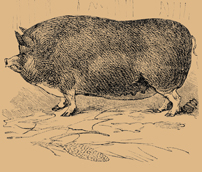
We cousins tussled for the bladder. The victor got to push in a hollow cane and blow up the organ as big as he dared. Then we all stood around and ”bomped” its taut sides until it burst. An Ozark “balloon” seldom lasted more than an hour.
— James C. Hefley, Way Back in the Hills, 1987
Vance Randolph
....Told me a tale he heard as a boy in Taney County, missouri, in the nineties.There was a very wicked man living there — a man who opposed all religion and refused to help build the meetinghouse. His family had drifted away, and the fellow was dying alone, cursing at every breath. Some neighbors came over to take care of him, and while they were there a bolt of lightning fell out of a clear sky and set the house on fire.

Two big men tried to carry the dying infidel out but couldn’t lift him off the bed. Then they tried to move the bed, but even their great strength could not budge it an inch. Soon the house became intolerably hot, and the neighbors left just before the roof fell in. A strange black dog slipped out at the same time, apparently from under the sick man’s bed. When the ashes cool, there was no sign of the infidel’s body — “nary a bone!”
— Vance Randolph, Ozark Magic & Folklore, 1946
plate 1. Top, Jacks Fork River, February 18, 2009.

plate 2. College of the Ozarks Campus, Point Lookout, Missouri. October 28, 2011.
The Falling Star
I saw a star slide down the sky,
Blinding the north as it went by,
Too burning and too quick to hold,
Too lovely to be bought or sold,
Good only to make wishes on
And then forever to be gone.
— Sara Teasdale
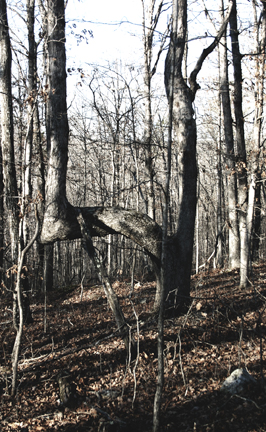
plate 3. Indian Tree, Greer Spring near the Eleven Point River, Missouri. February 19, 2009.
“Words are, in my not-so-humble opinion, our most inexhaustible source of magic. Capable of both inflicting injury, and remedying it.”
― J.K. Rowling, Harry Potter and the Deathly Hallows
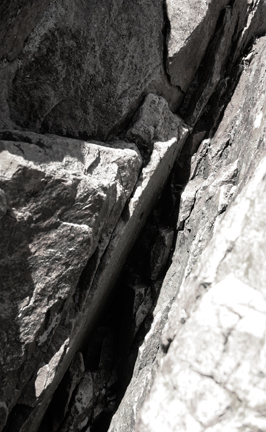
plate 4. Rocky Falls, Shannon County, Missouri. February 19, 2009.
Jory Sherman:
The woods are steep on one side and there is a high bank on the other side that hides the pasture where my neighbor’s cows graze. For all I know there may be antelope over there, or buffalo. For all I know there may be a band of Osage Indians wandering over to the very spot where I stand, near-naked, bow in hand, flint and bone hooks rattling in leather pouches.... It seems that my legs are caught in this stream forever, rooted here between shifting shade and sun. If I stay here, like this, none of it will go away, ever. If I stay here, in this magic place and time, the summer will never end.
— Jory Sherman, My Heart is in the Ozarks, 1982

plate 5. Rocky Creek near Klepzig Mill, Missouri. February 20, 2009.
Charles Morrow Wilson:
Sammy invited me to set a spell and wet my gullet with a dipperful of persimmon beer. The latter proved to be a murky pink syrup which fortified a honeylike sweetness with a rocking, hammerlike blast of alcohol. “A reel friendly drinkin’ licker,” Sammy said. “Next to starberries and walnuts, ripe persimmins is the best flavor there is...meanin’ persimmin beer is the best drink there is.... Pervided,” he amended, “hit’s made proper to leave a man the strength to swaller and keep on settin’ or walkin’ ... persimmin beer keeps a man young.
— Charles Morrow Wilson, The Bodacious Ozarks: True Tales of the Backhills, 1959

Dylan Thomas:
For dinner we had turkey and blazing pudding, and after dinner the Uncles sat in front of the fire, loosened all buttons, put their large moist hands over their watch chains, groaned a little and slept.
Mothers, aunts and sisters scuttled to and fro, bearing tureens. Aunt Bessie, who had already been frightened, twice, by a clock-work mouse, whimpered at the sideboard and had some elderberry wine. The dog was sick. Auntie Dosie had to have three aspirins, but Auntie Hannah, who liked port, stood in the middle of the snowbound back yard, singing like a big-bosomed thrush.
I would blow up balloons to see how big they would blow up to; and, then when they burst, which they all did, the Uncles jumped and rumbled.
— Dylan Thomas, A Child’s Christmas in Wales, 1952

plates 6-7. Welsh Christmas Balloon.
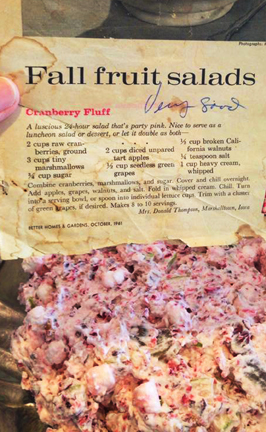
Cranberry Fluff (Fall Fruit Salads) from Cindy Clark, Searcy, Arkansas.
Cranberry Fluff from Cindy Clark
2 cups raw cranberries, ground
3 cups tiny marshmallows
1/4 cup sugar
2 cups diced unpared tart apples
1/2 cup seedless green grapes
1/2 cup broken walnuts
1/4 teaspoon salt
2 cup heavy whipped cream
Combine cranberries, marshmallows, and sugar. Cover and chill overnight. Add apples, grapes, walnuts and salt. Fold in whipped cream. Chill. Turn into a serving bowl, or spoon into individual lettuce cups. Trim with a cluster of green grapes, if desired. Makes 8 to 10 servings.
— Better Homes & Gardens, October 1961
